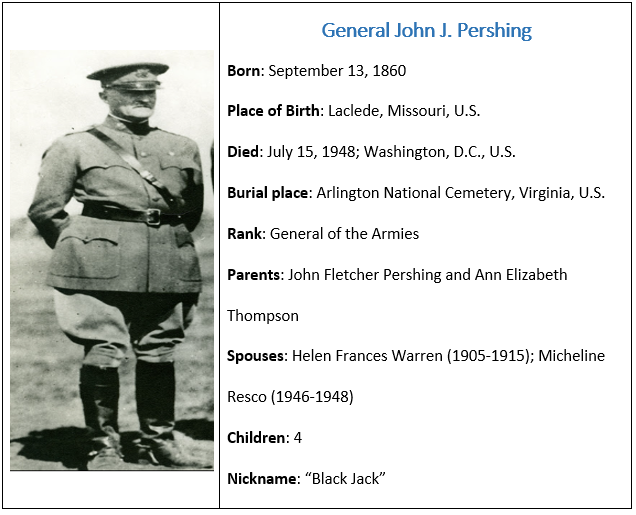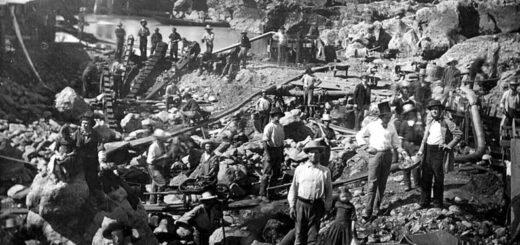John J. Pershing: Biography, World War I, Achievements & Other Notable Facts
Undoubtedly the most accomplished and celebrated American general of the early 20th century, John J. Pershing was famous for serving as commander of the American Expeditionary Forces in World War I. His successful military campaign during the First World War earned him the promotion to the rank of “General of the Armies of the United States” in 1919, the second person ever to receive such honor.
From a farmhouse in Linn County, Missouri, John Joseph Pershing grew up to become a distinguished American Officer and mentor to some of America’s finest such as George C. Marshall, Dwight D. Eisenhower, and Douglas MacArthur.

John J. Pershing (1860-1948): one of two six-star generals in the history of the United States
Biography
Pershing was born the first of nine children in September 1860 to farmer John Fletcher Pershing and homemaker Ann Elizabeth Thompson. As a teenager, he had to take care of the home and attend school while his father worked as a traveling salesman.
In 1880, this brilliant student graduated from Kirksville Normal School with a Bachelor of Science degree in scientific didactics (teaching). He taught for a while at Prairie Mound School and wanted to go back to Kirksville (now Truman State University) to study law, however, he saw an advertisement for admission into the United States Military Academy at West Point. He was the only one selected from his district in 1882 to attend West Point. Pershing later graduated 30th in a batch of seventy-seven students in 1886.

Pershing in his early years as a cadet in 1886
Military Career and Pre-World War I Military Campaigns
Pershing started his career serving in the Sixth Cavalry, fighting Native Americans to protect the white settlers. He fought the Geronimo-led Apache in New Mexico and Arizona and he learned Apache dialects and Plains sign language.
Pershing taught at the University of Nebraska and used the opportunity to get a law degree in 1893. He was promoted to First Lieutenant of the 10th Cavalry, becoming one of the first white officers to command an all-Black (Buffalo Soldier) regiment where he earned the nickname “Black Jack,” however, some historians insisted he got the nickname because of his strictness and discipline.
He led the Buffalo Soldiers into the Spanish-American War (April 21 – August 13, 1898) in Cuba, Puerto Rico, and Guam, and the bravery of his all-black troops earned Pershing respect and admiration.
Pershing was stationed in the Philippines after America defeated Spain and his troops constantly had to fight insurgency from the “Moros Tribe,” who opposed America’s control of the Philippines. He soon learned their language and customs which helped him to gain the trust of the locals.
In 1905, President Theodore Roosevelt used his presidential prerogative to make an unusual decision and nominated Pershing as a brigadier general, from the rank of captain. The promotion, which was approved by Congress, proved to be a bit controversial because Pershing passed over eight hundred officers who were previously his seniors in the army.
Heroics in World War I
The First World War started after the assassination of Archduke Franz Ferdinand of Austria in 1914, and the United States did not join the war until 1917.
Pershing was appointed commander of the American Expeditionary Forces (AEF), the U.S. military troop sent to Europe by then-U.S. President Woodrow Wilson. Hew was also promoted from Major General to full General in May 1917.
This dashing officer faced the daunting task of organizing and training 130,000 soldiers. The European Allies were exhausted after three years of fighting and wanted the American troops to join them immediately but Pershing rejected this idea. He insisted a united American front would demoralize the Germans. He also maintained that the training methods used by the U.S. and the European armies were different from each other and if they fought together it would be a mess.
Politicians and Congress members did not allow Pershing’s original Buffalo Soldier regiments to fight in World War I, instead they were relegated to logistics and support. However, as the demand for manpower grew, thousands of additional African Americans were conscripted to join the fight in the Great War. Pershing was more than willing to lend the new soldiers to the French army to fight with the French. These African-American soldiers were given the American uniform but told to use the blue French helmet and utilize the French weapons.

General Pershing was the commander of the American Expeditionary Forces (AEF) on the Western Front during WWI. Image: Pershing’s face on Time magazine, August 11, 1924.
By the summer of 1918, the American troops’ successful military campaign alongside the French at the Second Battle of the Marne marked a turning point in World War I on the Western Front. The U.S. First Army was formed, under the command of Lieutenant General Hunter Liggett, and the Second Army was under Lieutenant General Robert Bullard. The breakout of the American troops from the Argonne at the start of November 1918 was a decisive event that pushed the Germans to accept and sign an armistice.
Pershing was largely credited for the American Expeditionary Forces (AEF)’s success and became the most celebrated American officer from the war. Although he was criticized for ordering the soldiers to keep fighting before the signed Armistice took effect, resulting in over 3,000 dead American soldiers. To his defense, Pershing insisted they were not sure if Germany would act in good faith or would use the Armistice to gain time and remobilize their troops.
Unperturbed by the 1918 Spanish flu pandemic, which at the time was abating, Pershing rode his horse in the Paris victory parade in 1919.
Accomplishments of John J. Pershing
In 1919, General Pershing was honored by Congress with the rank of “General of the Armies.” This special honor allowed him to be on “active duty” for the rest of his life and continue to be available for assignments. He was the first American to be bestowed such an honor, although, in 1976, U.S. President Gerald Ford promoted George Washington, our nation’s first president, to this rank as part of the United States Bicentennial.
In 1921, this Missouri-born soldier was appointed Chief of Staff of the United States Army and served three years before retiring on his 64th birthday. He was instrumental in the construction of the Liberty Memorial (National World War I Museum and Memorial). Pershing was on the cover of the August 1924 edition of “Time Magazine.” and was awarded the 1932 Pulitzer Prize for history for his book “My Experiences in the World War.”

In 1976, he was posthumously awarded the General of the Armies of the United States – the most senior military rank in the United States Army. Washington, who is considered by many as one of the greatest presidents of our nation, is one of two people to hold that military honor. The other is John J. Pershing, who received his in 1919 for heroic efforts during World War I. Portrait by Charles Willson Peale (1776)
Personal Life

The Pershings – Pershing with his wife Helen Frances Warren and three of their children
In 1905, Pershing married Helen Frances Warren, the daughter of powerful U.S. Senator Francis E. Warren, a Wyoming Republican. By Helen, he fathered four children: Helen, Anne, Warren, and Mary Margaret.
On August 27, 1915, his wife and three daughters were killed in a fire incident at their home at the Presidio in San Francisco. It is reported that Pershing never recovered from this loss, his son Warren was raised by his sister, May.
In 1946, an 85-year-old Pershing married Romanian artist Micheline Resco, who was 35 years his junior.
Death
General Pershing died on July 15, 1948, of congestive heart failure at age 87 at Walter Reed Army Medical Center in Washington, D.C. He was laid in state at the United States Capitol rotunda and given a state funeral. The general was buried at Arlington National Cemetery in Virginia.
Legacy

Pershing helped train a number of generals who would later fight in World War II. Some of those generals were Douglas MacArthur, Omar Bradley, and Dwight D. Eisenhower. The latter, the hero of World War II, later served as the president of the United States. Image: General Pershing and members of his staff at Headquarters, Chaumont.
Pershing’s greatest accomplishment was the formation of the American Expeditionary Forces, without his military brilliance and involvement of the Americans in the first world war, the European allies could have been defeated.
This American hero mentored officers who became significant figures in the Second World War such as future President Harry S. Truman.
Did you know?
Pershing’s son Colonel Francis Warren Pershing served during the Second World War. Warren’s sons John and Richard also served in the Vietnam War; unfortunately, Richard was killed in action on February 17, 1968.
Pershing is the only person in the history of the United States to earn the rank of General of the Armies while still alive. The rank, which is the highest possible rank in the U.S. Army, allows the holder to pick his own insignia and uniform color. Some historians like to equate the General of the Armies to a six-star general.
Even though he was bestowed upon such a distinguished honor, the general continued to use his four-star military insignia.

John J. Pershing: Biography, World War I, Achievements & Other Notable Facts



























